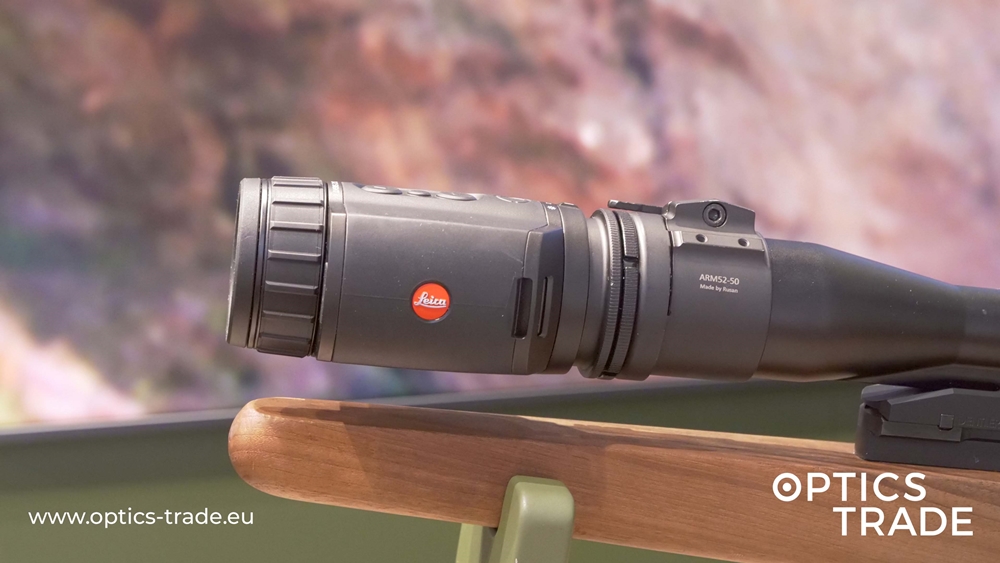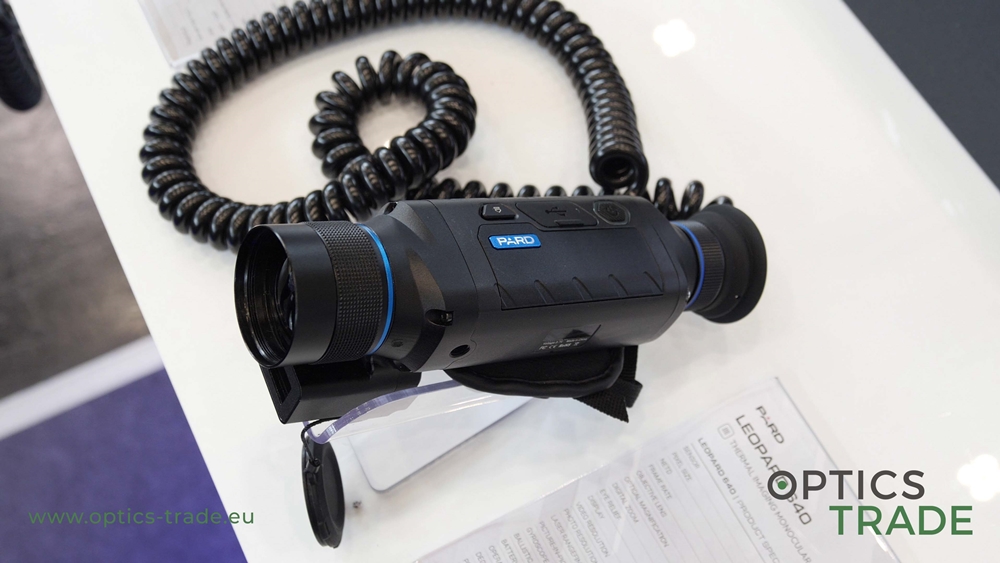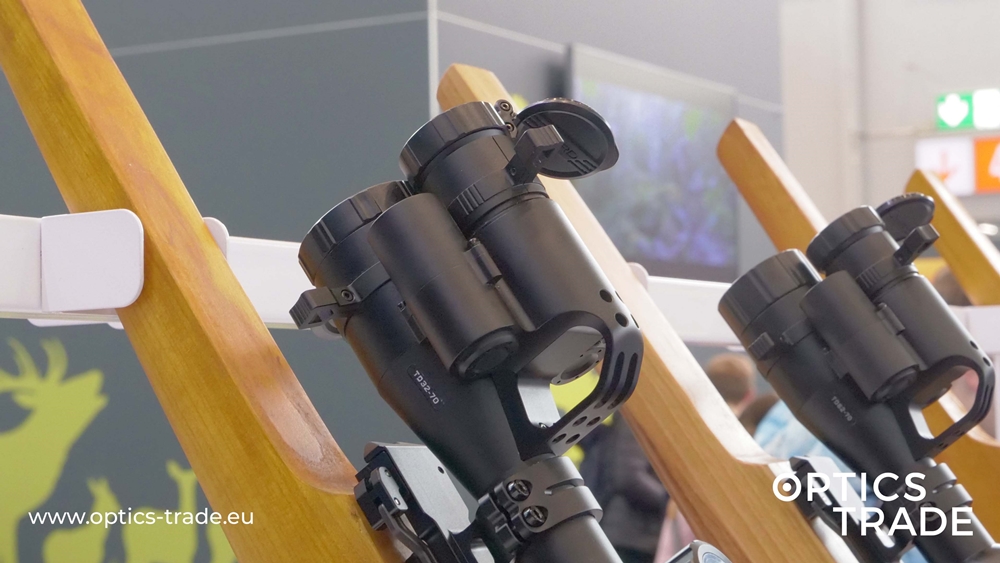The Pulsar Merger LRF XL50 represents the latest addition to the Merger series of thermal binoculars. Succeeding the renowned Accolade series, the Merger series has garnered significant popularity. Introduced at the IWA fair in 2023, the XL50 stands as the newest model in this series. Additionally, the Merger LRF XP50 is another notable model within this range.
- About the Pulsar
- Pulsar Merger LRF XP50 VS Pulsar Merger LRF XL50
- Pulsar Merger LRF XL50 Review
- Physical Properties
- Merger LRF XL50 Detection and Range Finding Range
- Optical Performance
- The Menu
- Scope of Delivery
- Pulsar Merger LRF XP50 Price and Warranty
- Pros
- Cons
- Final Thoughts
- Comparative Analysis of Thermal Binoculars: Merger LRF XL50, Hikmicro Raptor RQ50 L, and Guide DN 650
- Looking for more articles to read?
- Gallery

About the Pulsar
Pulsar, headquartered in Lithuania, holds the top spot in the civilian thermal imaging market. They were among the pioneers in offering thermal imaging solutions to civilians. While their products primarily cater to hunters, they are also extensively used by police, rescue teams, and a diverse range of individuals for various applications.
Pulsar Merger LRF XP50 VS Pulsar Merger LRF XL50
| Merger LRF XL50 | Merger LRF XP50 | |
| Thermal Sensor Resolution | HD 1024×768 | 640×480 |
| Pixel Pitch | 12 µm | 17 µm |
| Field of View | 14×10.5/24.6×18.5 | 12.4×9.3/21.8×16.3 |
| Detection Range | 2300 m | 1800 m |
| NETD | < 40 mK | < 25 mK |
| Internal Storage | 64 GB | 16 GB |
The primary distinction between the XL50 and XP50 lies in their thermal sensors. The XL50 integrates a high-resolution sensor, boasting an impressive 1024×768 pixels and a pixel pitch of 12 microns. In contrast, the XP50 model features a lower-resolution sensor of 640×480 pixels with a pixel pitch of 17 microns. As a result, the XL50 offers significantly enhanced detail, especially when zooming in on a target, particularly at larger magnifications. Therefore, the more you zoom in, the more pronounced the disparity becomes.
The XL50 model offers a slightly larger field of view, measuring 24.6 meters at 1000 meters, whereas the XP50 model provides a field of view of 21.8 meters at the same distance.
The XL50 model offers an extended detection range of 2300 meters, surpassing the XP50 model’s range of 1800 meters. The XL50 boasts a NETD lower than 40 millikelvins. In comparison, the XP50 has a lower NETD value of under 25 millikelvins. The XL50 model boasts a larger internal storage capacity of 64 gigabytes, compared to the 16 gigabytes on the XP50 model.
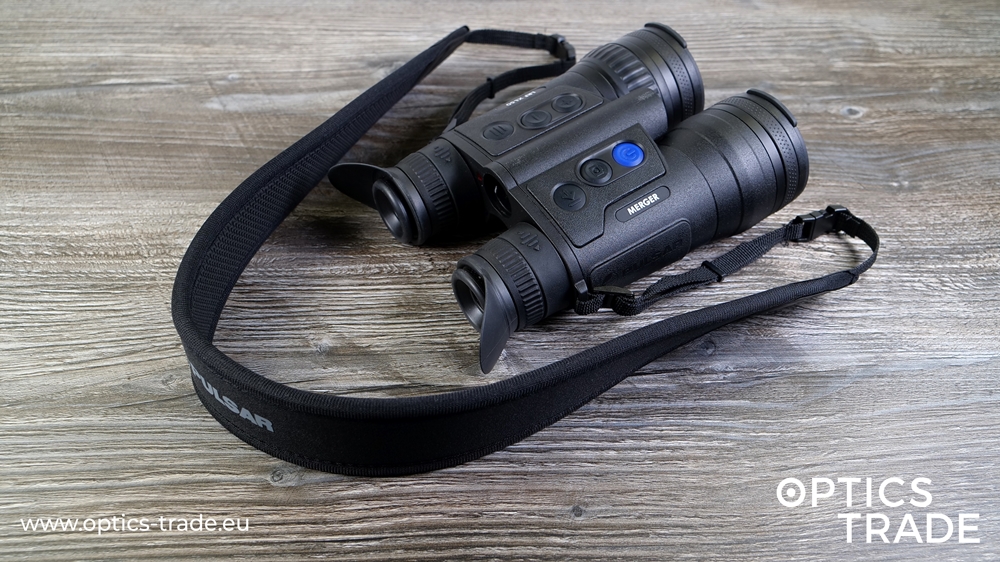
Additionally, there are slight variations in dimensions, albeit minimal, with a difference of only a few millimeters. When comparing both models side by side, it becomes evident that the devices are virtually identical. The only discernible variations lie in their objectives. The XL50 model features an additional ring on the barrels and is slightly longer, serving as the sole visual distinction between the two. Furthermore, upon closer examination of both devices from the rear, one can discern minimal disparities between the two.
There is a significant price difference between the two devices. The XL50 model costs approximately 2000 euros more than the XP50 model, making it the most expensive Pulsar device currently in production, priced at 6,490 euros. However, it is also the best option available from Pulsar, with unparalleled features and offerings.
Are you interested in learning more about the Merger LRF XP50?
Pulsar Merger LRF XL50 Review
Physical Properties
Housing
The housing of the Merger XL50 remains unchanged from the older XP50 model, featuring a sturdy magnesium construction that ensures durability. It operates flawlessly within a temperature range of -25 to +50 degrees Celsius. In terms of dimensions, it measures 197 millimeters in length, 140 millimeters in width, and 72 millimeters in height. The Merger weighs 950 grams, batteries included, excluding the strap. When you factor in the included strap, the total weight of the device comes to approximately one kilogram.
Eyepieces and Diopter Setting
The eyepieces are rubberized, and they come with rubberized covers as well. When you find yourself engulfed in total darkness, you effectively become imperceptible to animals as the emitted light from the device remains confined within it, leaving you virtually invisible. However, if you prefer not to use them, they can be easily pushed back.
The interpupillary distance, which refers to the distance between the eyepieces, can be adjusted individually for each eye. This distance ranges from 62 millimeters to 74 millimeters. I have narrow-set eyes, so using regular 8×56 binoculars can sometimes be challenging for me. I find this particular model to be considerably more convenient for comfortable viewing. Additionally, both eyepieces have separate diopter settings, allowing for precise customization to ensure optimal viewing experience.

Two Batteries
What makes XL50 thermal binoculars special is its dual battery system. It features both an integrated battery and an external one, providing users with the flexibility to swap batteries even when the device is turned on. The startup time for this device is impressively quick, taking just around six seconds.
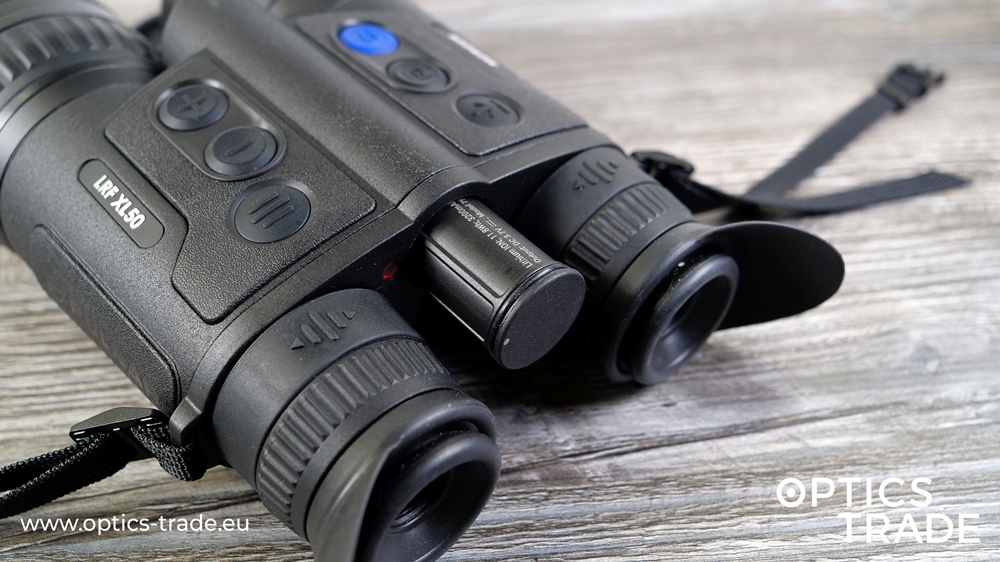
The Merger XL50 is equipped with a 4,000-milliamps internal battery, along with the APS3 battery boasting a capacity of 3,200 milliamps. As mentioned earlier, the convenience of swapping the battery while the device is powered on allows for uninterrupted usage. The screen displays separate power indicators for each battery, allowing you to quickly identify which one is depleted.
The external battery comes with a rubber cover, which is a great feature. It protects the battery connectors, especially if you carry the battery in your bag. The package includes an external charger that can simultaneously charge two APS3 batteries. The device has a battery life of approximately eight hours. It is one hour less compared to the XP50, which I believe is due to the more advanced sensor that consumes slightly more electricity.
Need a spare battery?
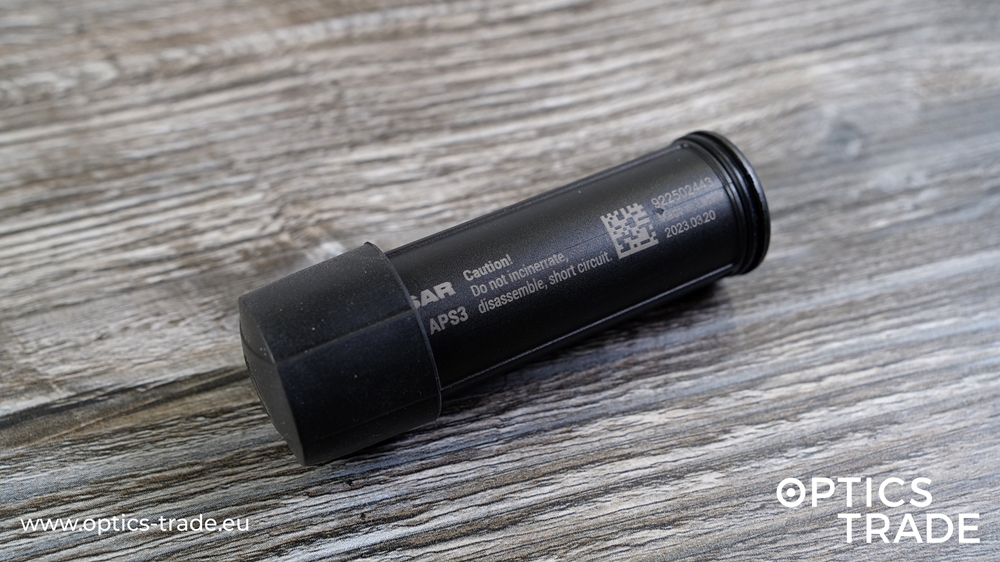
Sleep Mode
The device also features a sleep mode. A small sensor is positioned near the left eyepiece, detecting when you are peering through the device. It can detect your proximity to the device and, if you move away, it senses that there is no longer anyone using it and promptly turns off the thermal device to conserve battery life. However, as soon as you approach the device, it instantly powers back on, allowing you to resume using it without delay.
Additionally, there is a manual sleep mode option available. Simply press and hold the on and off button for a few seconds to activate sleep mode. To completely power off the device, hold the button for an extended period.
Video and Photo
The Merger XL50 offers video recording and photo-capturing capabilities. It boasts a video resolution of 1024×768 pixels. The videos are stored as MP4 files, while the photos are in JPEG format. Additionally, there is a convenient built-in microphone that can be easily activated or deactivated based on your needs.

Connectivity
The device offers Wi-Fi connectivity, with the option to switch between 2.4 and 5 gigahertz frequencies. It also has a type C USB port at the rear for multiple purposes – connecting to a PC, direct device charging, and even connecting to a power bank if needed. For smartphone integration, the Merger XL50 can be linked using the Stream Vision 2 app.
Internal Storage
The internal memory of the device is significantly larger, with a capacity of 64 gigabytes compared to the XP50’s 16 gigabytes. With 64 gigabytes, you can store approximately 40 minutes of uncompressed video or 100 hours of video with compression enabled.
Sensor, NETD and Display
The Merger XL50 features a new uncooled HD sensor with 1024×768 pixels and a pixel size of 12 microns. It operates at a refresh rate of 50 hertz and boasts a noise equivalent temperature difference (NETD) of under 40 millikelvins. This device features an AMOLED HD display with a resolution of 1024×768 pixels.
Calibration Modes
The Merger XL50 offers three different calibration modes:
1. Automatic mode: The calibration process is fully automated, requiring no manual button pressing on your part.
2. Manual calibration: For manual calibration, you need to press the button yourself. As you do so, you’ll hear the distinct clicking noise of the shutter.
3. Manual mode: With the fully manual mode the shutter is disabled. However, in this case, you’ll need to manually close the lens cover.
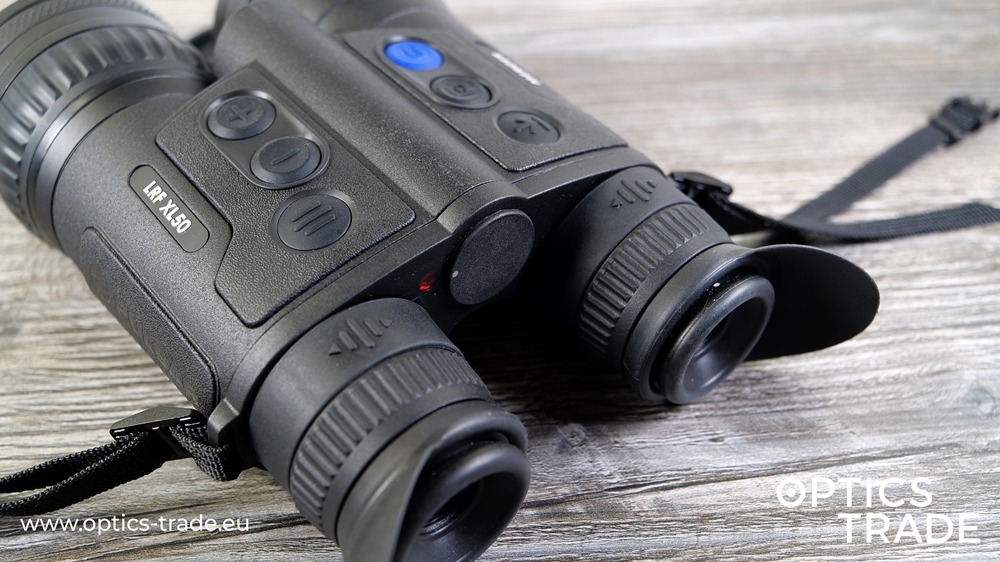
Merger LRF XL50 Detection and Range Finding Range
The Merger LRF XL50 has a detection range of 2,300 meters. Additionally, this device offers eight different color modes, allowing for seamless switching while observing through the device. The laser range finder has a maximum range of 1000 meters and a minimum range of five meters, with an accuracy of plus or minus one meter.
To operate the laser range finder, locate the first button on the top of the right-side barrel. With a quick press of the button, the device will promptly display the distance to the target, typically within two seconds of measuring. For an extended press, you will enter the scan mode, where the device will continuously update and display the distance to the target every second. To exit the scan mode, simply press and hold the button for an extended period.
Another remarkable aspect is that the laser range finder functions flawlessly even in adverse weather conditions. We extensively tested various devices, and it was only the Pulsar thermal device that excelled in challenging environments and provided accurate measurements even at longer distances.

Equivalent Horizontal Range Calculation
The XL50 device brings a new capability that the XP50 model lacks: the ability to calculate the equivalent horizontal range. Whether you’re measuring uphill or downhill, this device provides the precise distance you need to engage with your shot – the true range to your target. Of course, if desired, this feature can be easily disabled in the menu. However, it’s worth noting that the device currently lacks ballistic software, which, in my opinion, would make it truly exceptional.
Optical Performance
Analog and Digital Magnification
The device offers an analog magnification of 2.5 times, with the added capability of digital zoom up to 20 times. This provides a significant range for zooming in. However, it’s important to note that, like other digital devices, the image quality may suffer as you increase the magnification, as it zooms in on individual pixels. Nevertheless, due to the new sensor technology, there are plenty of pixels to work with, which is a notable strength of this device.
Even when using maximum magnification, the XL50 model delivers exceptional image quality with rich details. At 20 times magnification, the image remains clear and easily distinguishable. In comparison, the XP50 model falls short, displaying noticeable pixelation at the same magnification. While the XL50 model does exhibit some pixelation at 20 times magnification, it is significantly less pronounced than on the XP50 model. The image quality of this device at higher magnifications is truly astonishing. To truly appreciate the difference, one must experience it firsthand.
At a lower magnification of 2.5x, there is a subtle distinction from the XP50 model, although it can be challenging to discern. However, as magnification increases, the disparities become increasingly apparent.
Lens and FOV
The XL50 device features a 50mm lens with a fast aperture of 1.0. Positioned on the right side of the lens is the laser rangefinder, which consists of a laser lens and a receiver lens. As previously mentioned, the field of view spans 24.6 meters in width and 18.5 meters in height when measured at a distance of 100 meters.

Focusing
The close focus is situated on the right side of the barrel. By using the focus ring, you can adjust the image based on the distance. Although the exact close focus distance is not specified, based on my observation it appears to be around eight meters, representing the minimal focus. The positioning of the focusing ring is convenient, allowing for easy manipulation while observing.
The Menu
The arrangement of buttons on the device is excellent. When using the device, you can easily reach all the buttons with your fingers. This design provides a high level of comfort during use.
Now, let’s explore the main menu, where you’ll find a plethora of options to choose from. These include the amplification level, color modes, and the smoothing filter, which effectively reduces digital distortion. The user mode allows you to save your preferred brightness and contrast settings. You can also adjust the icon brightness, activate or configure Wi-Fi settings, toggle the microphone on or off, fine-tune the range finder settings, access calibration mode, and explore general settings. Additionally, there’s an option to repair defective pixels and view detailed device information.

The Buttons
Located at the beginning of the row on the left side barrel, the menu button grants access to two different menus based on the duration of the press. A quick press activates the quick menu, while a long press opens the comprehensive device menu.
The blue button serves as the switch to power the device on and off. With a quick press while the device is on, you can calibrate your picture. Holding the button for about two seconds activates sleep mode, while a longer hold powers the device off again.
By briefly pressing the plus button, you can adjust the magnification. On the other hand, a long press will activate the picture-in-picture mode, allowing you to view a zoomed-in picture in the upper front of the display.
The minus button controls the amplification level. By pressing the button long, you can switch between the white-hot and black-hot image modes.
The picture and video mode can be accessed using the middle button on the right barrel. A short press activates either the video or photo mode, while a long press allows you to switch between the two.

Scope of Delivery
The box with the Merger LRF XL50 includes several items. Firstly, you will find a convenient carrying strap. Additionally, there is a user manual for the Stream Vision 2 app, along with detailed instructions on how to install and use it. However, for a comprehensive user manual, you will need to scan the QR code provided in the manual. You’ll also receive a warranty certificate with three years of coverage, as well as a quick start guide for the Merger.
Next, you have the APS 3 battery and a charger that can accommodate two APS3 batteries simultaneously. This charger offers a powerful 30-watt charging capability. Additionally, you’ll receive a USB cable that includes both a standard USB and a type C USB connector.

Additionally, there is a tripod adapter available for the device, allowing for easy installation. This adapter lets you mount the device on a tripod, allowing for extended observation. The device also comes with cleaning cloth and a stylish carrying bag for added convenience.

Pulsar Merger LRF XP50 Price and Warranty
The Merger LRF XL50 is manufactured in Lithuania, within the European Union, and is accompanied by a three-year warranty. Another advantage is the presence of the service department within the EU, specifically in Lithuania. This means that for any warranty issues, there is no need to send the product to Asia or any other distant location.
As previously mentioned, the XL50 thermal binoculars are priced at 6490 euros.
Pros
Firstly, let’s discuss the positives of the device. To begin with, I appreciate the fact that the device is constructed in the form of a standard binocular, making it easy to hold and manipulate. Additionally, this design is familiar to most hunters. Another aspect I admire is the inclusion of both internal and external batteries, providing ample power for extended usage.
Battery life is frequently a significant consideration when it comes to thermal devices. Yet, with the XL50, you can effortlessly observe all night long without any concerns. I believe this to be an exceptional feature.
The image quality of this product is outstanding, surpassing all other civilian-used products I have come across. It is particularly impressive when zooming in on the target. The image quality is unmatched, even when compared to the XP50 at higher magnifications.
The quality of the build and design of this product are exceptional, as I mentioned before. It boasts an IPX7 rating, making it completely waterproof up to a depth of one meter for 30 minutes. I appreciate the inclusion of an integrated laser range finder, which provides instant distance measurements to the target, even in low-light conditions.
Pros Summary:
1. great design
2. long battery life
3. 2 batteries (external and internal)
4. LRF

Cons
While the Merger XL50 is undoubtedly a remarkable device, like any product, it’s not without its flaws. The range of the laser rangefinder could do with some improvements, as the current range of 1000m seems rather limiting for a device in this price category. The absence of ballistic software is another shortcoming, and its integration would undoubtedly add an extra layer of functionality and convenience for the user.
Although I believe this product is the best for the civilian market, the price of 6,500 Euros is quite steep. You are indeed paying for exceptional image quality, but in my opinion, the price is still quite high.
Cons Summary:
1. only 1000m rangefinder range
2. no ballistic software
3. high price

Final Thoughts
In summary, the Merger LRF XL50 exhibits an impressive array of features that sets it high on the list of thermal binoculars for serious enthusiasts and professionals. Its superior image quality, even at higher magnifications, is a testament to the technological prowess of the manufacturer.
The integrated laser rangefinder, providing accurate distance measurements even in low-light conditions, is another feature that I find to be an excellent inclusion. The binocular design is user-friendly and practical, while the generous battery life and dual battery system further underscore its performance capabilities.
The overall build quality, image clarity, and well-thought-out features more than compensate for the steep price tag. It’s an investment for those who demand the best and are willing to pay for it. The device’s ability to deliver excellent performance consistently makes it a worthwhile addition to any professional’s gear.
Searching for Merger Thermal Binoculars? Find them below!
Comparative Analysis of Thermal Binoculars: Merger LRF XL50, Hikmicro Raptor RQ50 L, and Guide DN 650
Which product competes directly with the Merger LRF XL50 thermal binoculars? I believe the Hikmicro Raptor RQ50 L is a strong contender, priced approximately 1,200 Euros lower than Merger. Not only does it offer night vision capability, but it also provides the option to switch to fusion mode.
However, the image quality is incomparable. As previously mentioned, the Merger device truly excels in this aspect. Additionally, Hikmicro is constructed entirely from plastic, which lacks the same level of quality and tactile feel as the Merger. Furthermore, it is manufactured in China, meaning that in the event of any issues with the Hikmicro, it would need to be sent back to China for repairs. Consequently, the repair process is undoubtedly lengthier compared to that of the Pulsar.
Need more information about Hikmicro Raptor RQ50 L?
In my opinion, the Guide TN 650 is another device that competes with the Merger. It boasts a sleek design and offers comfortable user experience. However, when it comes to image quality, it simply cannot compare to the Merger. Additionally, it is worth mentioning that the Guide TN 650, like the Hikmicro, is made of plastic and manufactured in China.
Looking for more articles to read?
Gallery






















